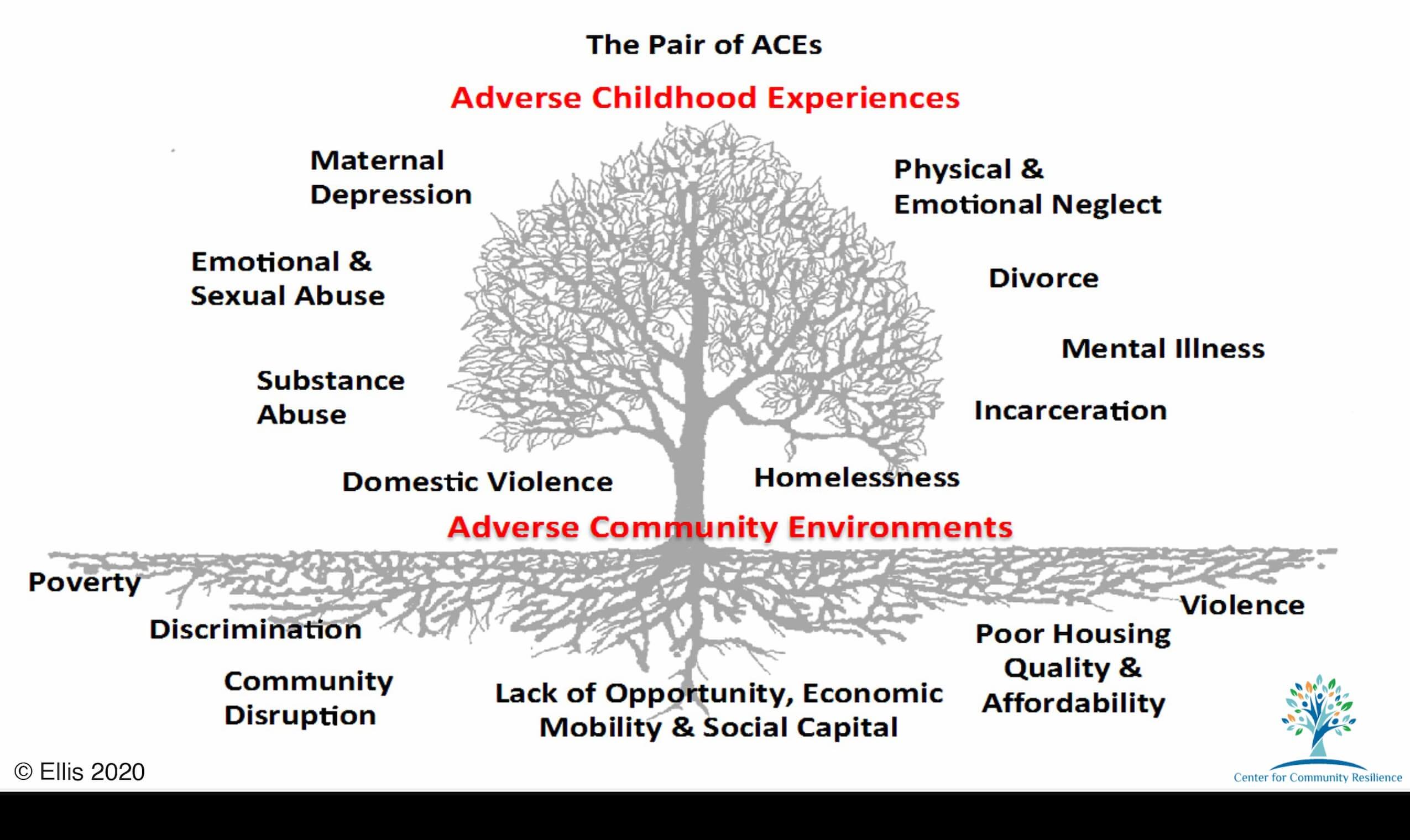Adverse Childhood Experiences (ACEs) Prevention
What Are ACEs?
Adverse Childhood Experiences (ACEs) are a collection of potentially traumatic events, such as violence, abuse, or neglect, that occur in childhood (0-17).
Childhood exposure to prolonged traumatic events may result in a toxic stress response, negatively affecting a child’s brain development. These disruptions increase the risk of poor physical health, coping skills, or other long-term cognitive impairments. Researchers and practitioners across many disciplines (e.g. development psychology, pediatrics, social work) had general knowledge of the connection between trauma and healthy development, however the 1998 landmark study by the Centers for Disease Control and Prevention (CDC) and Kaiser Permanente (ACEs Study) deepened this understanding.
The ACEs Study examined the effects of childhood trauma and stress on adult health outcomes. In this study, adverse childhood experiences were defined within ten categories: physical abuse, sexual abuse, emotional abuse, physical neglect, emotional neglect, violence against a mother, parental divorce, household member with substance use/abuse issues, household member with mental illness, and incarcerated household member. Overall, the researchers found that child adversity is common and exposure to one or more ACEs increases an individual’s risk of physical health, psychological, and social problems in adulthood. The pervasiveness of ACEs and their impact on various aspects of an individual’s life initiated a public health response to address this problem.
Key Facts
Nearly 2/3
of respondents in the initial ACEs study reported experiencing at least one adverse experience.
Felitti, V. J., Anda, R. F., Nordenberg, D., Williamson, D. F., Spitz, A. M., Edwards, V., … Marks, J. S. (1998). Relationship of childhood abuse and household dysfunction to many of the leading causes of death in adults. American Journal of Preventive Medicine, 14, 245–258.
Source: American Journal of Preventive Medicine
40%
of respondents in the initial ACEs study reported experiencing two or more adversities.
Felitti, V. J., Anda, R. F., Nordenberg, D., Williamson, D. F., Spitz, A. M., Edwards, V., … Marks, J. S. (1998). Relationship of childhood abuse and household dysfunction to many of the leading causes of death in adults. American Journal of Preventive Medicine, 14, 245–258.
Source: American Journal of Preventive Medicine
Pair of ACEs Tree
The Pair of ACEs tree helps illustrate the issues we aim to address when tackling ACEs. There are several strategies that can reduce or mitigate ACEs in our community. The CDC lists a number of strategies that aid in reducing or preventing ACEs. They are strengthening economic support to families, promoting social norms that protect against adversity and violence, ensuring a strong start for children, teaching skills, connecting youth to caring adults and activities, and intervening to lessen immediate and long-term harms.
Prevention
It is essential to understand that ACEs are preventable and that those who experience childhood adversity are not doomed to negative outcomes in their lives– adversity is not a destiny. Positive Childhood Experiences, or PCEs, have a favorable effect on healthy development and wellbeing and can prevent or mitigate ACEs. The Health Outcomes From Positive Experiences (HOPE) framework highlights PCEs in four categories being in nurturing, supportive relationships; living, developing, playing, and learning in safe, stable, protective, and equitable environments; having opportunities for constructive social engagement and connectedness; and leaning social and emotional competencies. This work can help build our collective understanding of preventing ACEs and building resilience.
Importantly, ACEs are preventable. Central to child adversity prevention is creating safe, stable, nurturing relationships and environments for all children and families.
How We’re Addressing ACEs
Prevent Child Abuse America’s research, programs, and affiliate network is focused on reducing ACEs through several practical solutions for creating the conditions for safe, stable, and nurturing relationships and environments for all children, families, and communities.

We work to strengthen economic supports through public policy work at the federal and state levels.

Our signature home visiting program, Healthy Families America, helps to ensure children have a strong start.

We promote social norms that protect against sexual violence and support positive parenting through public awarenes and engagment campaigns.
Outcomes
Impact
Research indicates that childhood exposure to one or more ACEs can have long lasting, negative effects on an individual’s health, wellbeing, and opportunity. ACEs may impact a person’s physical health associated with diabetes, cancer, a compromised immune system and chronic health problems later in life. Childhood adversity also affects mental health, leading to depression, substance abuse. Additionally, ACEs lead to social/behavioral issues, including poor social development, unhealthy coping behaviors, engagement in risky behaviors or violence.
Cost
ACEs are costly to society, the economic and societal burden of childhood adversity are upwards of hundreds of billions of dollars annually. Specific to child abuse and neglect, there are also enormous societal costs involved. A 2018 report estimated the lifetime economic burden of substantiated child abuse and neglect cases and child fatalities is approximately $592 billion nationwide. The U.S. spends large sums of money funding the child welfare system and allocates very few resources or time to the primary prevention of child abuse and neglect. For example, in 2016 the U.S. spent about $30 billion on child welfare services , whereas in FY2020, Congress only allocated $56 million to Community-Based Child Abuse Prevention (CBCAP) services — the largest dedicated federal source for primary prevention funding for child abuse and neglect.
Latest ACEs Resources
See more-

Taking ACES Upstream: Strengthening Prevention of Adverse Childhood Experiences
This report addresses the continued findings and research from the Adverse Childhood Experience (ACES) Study, which has identified robust associations between a child experiencing early trauma and a wide array of poor health, economic, and life outcomes.
Toolkits & Guides
-

New Data on ACEs
In this research review, we explore emerging research on adverse childhood experiences (ACEs), including interventions to address the consequences of ACEs, as well as examining key areas of limitation associated with the current ACEs framework.
Videos & Podcasts
-

Making the Case: “The Adverse Childhood Experiences Study: Child Abuse and Public Health” by Dr. Robert Anda
The Adverse Childhood Experiences (ACE) Study assesses the effects of child abuse and related adverse childhood experiences as a public health problem. Read more about this and download the full report.
Making the Case Series
Our ACEs Experts
Frequently Asked Questions About ACEs
The ACE Study and subsequent research indicates that ACEs are common. In the initial ACEs Study, researchers found that nearly two-thirds of respondents reported experiencing at least one adverse experience and about 40% reported exposure to two or more adversities., ACEs have a relationship with negative outcomes — where the number of childhood adversities experienced increases the likelihood of health risks.
Building upon this work, researchers sought to gather a nationally representative sample to further understand the effect of ACEs. Each year the CDC collects ACEs data in participating states through the Behavioral Risk Factor Surveillance System (BRFSS). The BRFSS is an annual phone survey of adults over the age of 18. The findings of BRFSS are similar to those in the ACEs study– ACEs are widespread, prevalence, and associated with poor outcomes.
Yes, Positive Childhood Experiences, or PCEs, have a favorable effect on healthy development and wellbeing and can prevent or mitigate ACEs. The Health Outcomes From Positive Experiences (HOPE) framework highlights PCEs in four categories being in nurturing, supportive relationships; living, developing, playing, and learning in safe, stable, protective, and equitable environments; having opportunities for constructive social engagement and connectedness; and leaning social and emotional competencies. This work can help build our collective understanding of preventing ACEs and building resilience.
Research indicates that childhood exposure to one or more ACEs can have long lasting, negative effects on an individual’s health, wellbeing, and opportunity. ACEs may impact a person’s physical health associated with diabetes, cancer, a compromised immune system and chronic health problems later in life. Childhood adversity also affects mental health, leading to depression, substance abuse. Additionally, ACEs lead to social/behavioral issues, including poor social development, unhealthy coping behaviors, engagement in risky behaviors or violence.
CDC
- CDC ACEs Report “Preventing Adverse Childhood Experiences (ACEs): Leveraging the Best Available Evidence” https://www.cdc.gov/violenceprevention/pdf/preventingACES.pdf
- CDC Presentation Graphics: https://www.cdc.gov/violenceprevention/aces/resources.html?CDC_AA_refVal=https%3A%2F%2Fwww.cdc.gov%2Fviolenceprevention%2Facestudy%2Fresources.html
- CDC General Page: https://www.cdc.gov/violenceprevention/aces/index.html
KPJR Films
- Paper Tigers: https://kpjrfilms.co/paper-tigers
- Resilience: https://kpjrfilms.co/resilience/
HOPE Framework
ACEs Too High
Building Community Resilience
- Pair of ACEs Tree: https://ccr.publichealth.gwu.edu/sites/ccr.publichealth.gwu.edu/files/pair%20of%20aces%20tree%202020%20CCR%20LOGO.png
- Pair of ACEs Tree (w/ narrative): https://publichealth.gwu.edu/sites/default/files/downloads/Redstone-Center/Resource%20Description_Pair%20of%20ACEs%20Tree.pdf
- Center for Community Resilience: https://ccr.publichealth.gwu.edu
There are several limitations to the ACEs framework, including limitations of the original definitions used and the ACEs screening. While the 10 original categories reviewed in the ACEs Study were important for our collective understanding of the prevalence of childhood adversity in our community, they are not broad enough. Many researchers advocate for adding other adverse experiences, such as poverty, peer victimization or rejection, exposure to community violence, among others to the ACEs assessment in order to understand ACEs more comprehensively.
The ACEs questionnaire should not be used as a screening instrument. While the tool provides information on the prevalence of ACEs, it provides little else. Instead, it is important for the field to shift efforts into understanding and establishing evidence-based intervention and prevention efforts pertaining to ACEs.
It is essential to understand that ACEs are preventable and that those who experience childhood adversity are not doomed to negative outcomes in their lives– adversity is not a destiny. Positive Childhood Experiences, or PCEs, have a favorable effect on healthy development and wellbeing and can prevent or mitigate ACEs. The Health Outcomes From Positive Experiences (HOPE) framework highlights PCEs in four categories being in nurturing, supportive relationships; living, developing, playing, and learning in safe, stable, protective, and equitable environments; having opportunities for constructive social engagement and connectedness; and leaning social and emotional competencies. This work can help build our collective understanding of preventing ACEs and building resilience.





